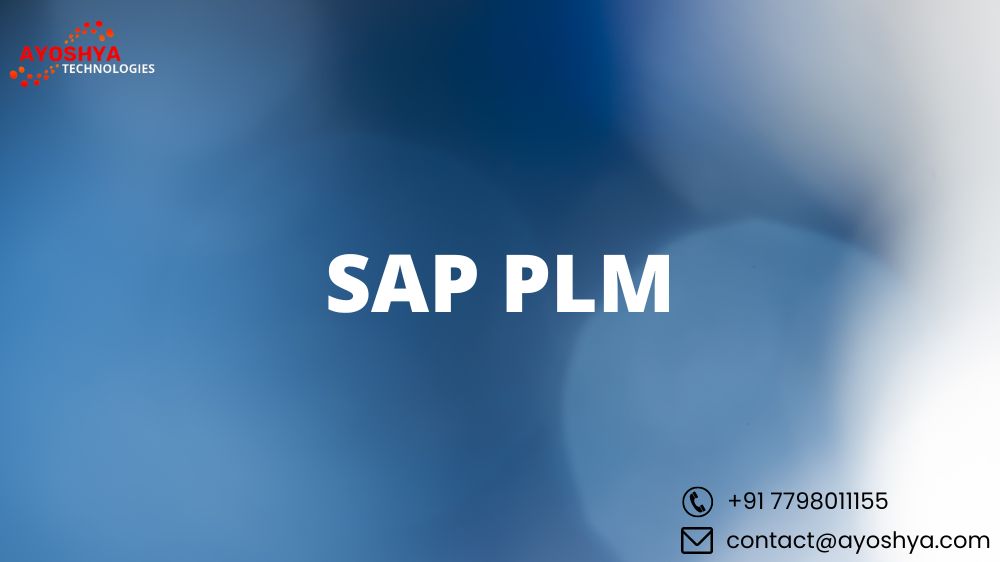SAP PLM
Specify SAP PLM.
Product Lifecycle Management (PLM) is a method for controlling a product’s lifecycle from conception to sales, services, and eventually retirement (Product Lifecycle Management). It forms the framework for the digital thread, ensuring flexibility in the supply chain and continuing business operations. Product lifecycle management assists companies in reducing costs, accelerating time to market, and achieving the highest levels of quality and compliance by providing data governance and traceability.
PLM software is a technology that helps organizations create and sell new products. The program makes it simple to track and transmit data along the whole value chain of a product, from initial design to production, supply chain management and operations, and asset maintenance.
Product lifecycle management software enables geographically distributed, interdisciplinary teams to collaborate strategically with partners and customers using trustworthy, up-to-date product information.
Foundations of PLM
In an era where innovation is crucial to corporate survival and success, SAP PLM plays a crucial role in helping manufacturers produce the next generation of goods at a reduced cost and with a shorter time to market. Although PLM may be viewed as a business strategy, three principles have an impact on how teams function and a company’s ability to grow and succeed:
Product definition information may be utilized and accessed securely on a worldwide scale.
maintaining the correctness of the product specification and any relevant data throughout the course of the product’s life.
The management and maintenance of the business processes related to the production, administration, sharing, and use of information.
Product development stages
There isn’t a single accepted industry standard when speaking of the stages of product development. On the other hand, a typical development cycle is represented by the phases listed below.
Concept and design: During the ideation stage, elements like competitor analysis, market insufficiencies, or client demands influence a product’s specifications.
Develop: The product’s exact design, along with any tools required for design, will be created. The validation and analysis of the anticipated product, the development of a prototype, and field testing are all parts of this process. This provides crucial information on how the product is being utilized and what other improvements are required.
Production and launch: In response to input from the pilot, the design and other components are updated to produce a version that is ready for the market. Before the new product is produced and made available to consumers, production is expanded.
The way a SAP PLM system works,
PLM solutions provide designers and engineers with instant access to the essential data they want. The solution streamlines project management and manages this product data across the whole product development lifecycle through integration with an ERP system, a bill of materials, other corporate data sources, and CAD (computer-aided design) data.
PLM also stops designers and engineers from working in a vacuum by providing them with access to other data sources, including consumer and analyst feedback on current products, field performance data, and visibility into the limitations of downstream processes like manufacturing.
Teams can benefit from a PLM system in areas other than design and engineering. It could provide company stakeholders and/or suppliers a “single source.”
Evolution
In the 1980s, American Motors Corporation (AMC) was a minor participant in the automotive sector. The absence of the considerable capital owned by the larger market participants limited the company’s ability to properly compete. AMC leadership created the first iteration of product lifecycle management with the intention of tracking products from conception through end-of-life in order to simplify operations and outperform the competition.
At every step, from the idea through the procurement and production processes, information was used to influence decisions. By the middle of the 1990s, AMC had surpassed all other automakers in terms of expense.
The manufacturing industry presently makes extensive use of PLM to promote cooperation, foster innovation, and successfully support growth by designing for consumer demand.
benefits of SAP PLM.
- The top five reasons why companies choose to invest in PLM systems are: Improvements to development, engineering effectiveness, and efficiency: According to a survey conducted by Industry Week, engineering teams perform worse when silos exist. PLM makes it possible for bidirectional real-time data flow, which enhances cooperation and knowledge sharing.
- Elimination of errors throughout the engineering release process: It is significantly easier and less expensive to fix problems with a product that are discovered early on. PLM reduces costs while also minimizing industrial waste, both of which are advantageous to the environment.
- Reduced time to market: PLM helps project managers manage competing deadlines and hasten the release of goods by offering a single source of truth with up-to-date information at every stage of the project.
- A cross-enterprise digital PLM system enables sophisticated workflow management for better project delivery. In this situation, PLM enables a team to more precisely estimate product prices and organize the transmission of new designs to manufacture.
- Because PLM offers designers and engineers a better understanding of product requirements, higher-quality designs are developed. A PLM system with integrated machine learning may translate performance statistics and customer input into new feature proposals by absorbing data from multiple internal and external sources.



